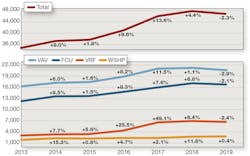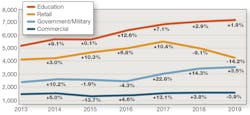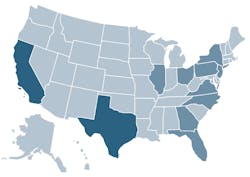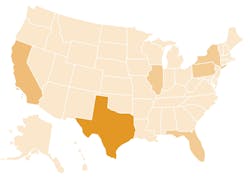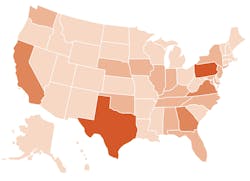Trends in HVAC Equipment Offer Window on Future
Technologies and methods used to heat, cool, and ventilate commercial buildings are continually evolving. Those whose job it is to specify, design, install, or operate and maintain building HVAC systems can keep up with the changes or ignore them, and risk being left behind.
As part of its continuous surveillance of the HVAC market, AMCA has partnered with consultant Applied Marketing Knowledge (AMK) to study trends in HVAC equipment application across the U.S. The AMCA/AMK team examined six years of construction-project specifications, plans, and addenda within the database of ConstructConnect, a provider of construction-management software and tools. This article summarizes the team’s findings.
Data Collection
The authors looked at construction projects from 2013 through 2019, focusing their study on the HVAC zone systems most commonly applied in commercial buildings: “variable air volume” (“VAV”), “fan coil unit” (“FCU”), and “water source heat pump” (“WSHP”), in addition to “variable refrigerant flow” (“VRF”), and “variable refrigerant volume” (“VRV”).
The scope of the study was commercial (broadcast studios, laboratories, offices, parking garages, rental warehouses, transportation terminals), educational (athletic buildings, cafeterias, dormitories, schools), retail (automotive, bank, entertainment, food stores, hotels, restaurants, shopping centers), government (courthouses, fire and police stations, government offices, park buildings, post offices, prisons, miscellaneous government buildings), and military (related housing, offices, miscellaneous other buildings) building projects in the planning, bidding, post-bid, or awarded stage, with specifications containing Construction Specifications Institute MasterFormat Division 23 (Heating, Ventilating, and Air Conditioning) information. It is important to note that while the authors excluded single-family residential projects, they did include multifamily projects (apartments, townhomes, condominiums), which often have commercial HVAC zone systems.
Data from research was supplemented with interviews of industry professionals. The interviews confirmed and provided greater insight into the project-search data.
Project-Search Results
Overall, 2013 through 2019 was a period of growth for the HVAC zone options studied. Growth in the number of projects employing the systems averaged 8.3 percent a year from 2013 to 2017, before settling at 4.4 percent in 2018. Last year, 2019, was the only time in the period that overall market growth declined, falling 2.3 percent (Figure 1).
Variable air volume. VAV-project growth followed a trajectory similar to that of overall market growth, averaging 6.8 percent a year from 2013 to 2017, before settling at 1.1 percent in 2018. Again, 2019 saw the only decline in VAV-project growth, with a drop of 2.9 percent (Figure 1).
The education and commercial buildings markets drove much of the volume in VAV units over the period studied. Education was the largest market for VAV in terms of number of projects (Figure 2). That commercial has the fewest projects in Figure 2 is somewhat misleading, as commercial projects typically have the most VAV boxes of any vertical market.
The retail, government, and military buildings markets showed much greater variability in number of projects than the other sectors. Retail was stronger in growth than government and military from 2013 to 2017, but lost much of that growth in 2018 and 2019. This is consistent with retail’s tendency to expand rapidly and then aggressively contract. Retail has begun to show signs of overall construction weakness as brick-and-mortar stores increasingly give way to online shopping.
Geographically, VAV generally mirrored the overall HVAC marketplace, with the largest concentrations of projects in the most-populated areas. The northeast corridor down through Washington, D.C., as well as Florida, Texas, California, and cities in the Midwest and Southeast, are where the majority of projects are located (Figure 3).
Fan-coil units. FCU-project growth averaged 6.7 percent a year from 2013 to 2018, before retreating 2.1 percent in 2019 (Figure 1). Volume in the FCU market tends to be dictated by the hospitality industry, with the most projects appearing in locations where there are large numbers of multi-story hotels, such as California, Florida, Texas, and the Northeast (Figure 4).
Water-source heat pumps. WSHP projects remained largely flat throughout the period examined (Figure 1). The number of projects was relatively small, ranging from 2,000 to 2,700 per year, from 2013 to 2019, which can make year-over-year percentage changes seem more dramatic. WSHP projects are most common where adopted by K-12 schools (Figure 5).
Variable refrigerant flow. VRF projects experienced faster growth than the overall market during this period (Figure 1). That growth was particularly strong in 2016 and 2017, which saw 25.5- and 49.1-percent annual growth, respectively. As with WSHP, however, the base of VRF projects is relatively low (about 3,000 projects in 2013), which makes for more dramatic percentage increases. But unlike with WSHP, the number of VRF projects more than doubled, to approximately 6,700, by 2019.
Generally speaking, trends in the U.S. often start in the West and move eastward. This is what the authors observed with VRF project-location data. The West Coast, as well as Texas, have many projects. Additionally, the data show more projects appearing in Missouri, Illinois, Florida, and the Eastern seaboard (Figure 6).
Interview Results
Equipment designers, manufacturers, and distributors as well as building owners were interviewed to determine if their experience squared with the data analysis.
The respondents confirmed VRF was growing faster than the overall marketplace. There was no consistent sense of the FCU market relative to the overall marketplace, and it generally was said the market for WSHP was flat or growing slightly slower than the overall market. Many respondents said there is little awareness of the relative health of the market for individual system types when the overall market is growing. People tend to notice individual-system trends only when the overall market slows, as HVAC did in 2019.
There was unanimous agreement that, of the technologies studied, VAV and FCU are the best suited for jobs calling for large-tonnage systems. VRF systems were seen as typically being aimed at small to midsize projects. Building maintenance personnel’s familiarity with system requirements was seen as heavily influencing the selection of, and ultimate satisfaction with, a system.
All respondents noted the importance of ventilation systems working in concert with heating and cooling systems. VAV stood out for its integration of ventilation with heating and cooling.
Trends Moving Forward
Though 2020 is shaping up to be a most unusual year because of the coronavirus pandemic and all of the disruptions and uncertainties it has caused, the authors do not expect any sudden or drastic changes to the trends observed in the data from the last six years. VAV likely will remain the dominant system choice for multiple-zone projects, as it is well-known and understood, scalable, and more easily applied to projects with many zones. VRF growth likely will continue at a pace faster than the overall marketplace, as newer products and enhanced ventilation options move the technology along its introductory growth curve. The FCU market is expected to grow more slowly than the overall marketplace, especially if VRF becomes more accepted in such traditional FCU markets as hotels, while the WSHP market is expected to remain mostly flat.
Conclusion
The six-year period studied was one of strength and growth for the HVAC industry. VAV is expected to continue to be the leading system type in multiple zones. VRF has grown at the expense of WSHP and is poised to move into more traditional FCU jobs. Moving forward, in light of the pandemic, building-system professionals will need to apply the same level of focus on ventilation they traditionally have put on heating and cooling. Reliable data analysis of application history will help manufacturers better understand system-use trends and help designers to make better decisions for their projects.
###########
Based in Denver CO, Gunzner is advocacy manager for AMCA International, which he joined in May 2019. Since then, he has assumed increasing responsibilities for many advocacy-related initiatives in North America. He holds both a bachelor’s and master’s degrees in mechanical engineering from Colorado School of Mines. Contact him at [email protected].
Based in Bonita Springs FL, Morrow is an experienced marketing and sales professional with more than 30 years of experience in the commercial buildings industry, primarily focused on HVAC work. He is managing partner for Applied Marketing Knowledge (AMK), a consulting firm specializing in the construction, engineering, and manufacturing fields. Morrow has a bachelor’s degree in mechanical engineering from Rose-Hulman Institute of Technology. For more info, go to: www.amk-llc.com.

